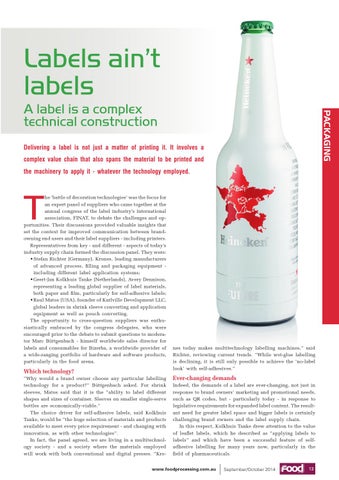Labels ain’t labels PACKAGING
A label is a complex technical construction Delivering a label is not just a matter of printing it. It involves a complex value chain that also spans the material to be printed and the machinery to apply it - whatever the technology employed.
T
he ‘battle of decoration technologies’ was the focus for an expert panel of suppliers who came together at the annual congress of the label industry’s international association, FINAT, to debate the challenges and opportunities. Their discussions provided valuable insights that set the context for improved communication between brandowning end users and their label suppliers - including printers. Representatives from key - and different - aspects of today’s industry supply chain formed the discussion panel. They were: • Stefan Richter (Germany), Krones, leading manufacturers of advanced process, filling and packaging equipment including different label application systems; • Geert-Jan Kolkhuis Tanke (Netherlands), Avery Dennison, representing a leading global supplier of label materials, both paper and film, particularly for self-adhesive labels; • Raul Matos (USA), founder of Karlville Development LLC, global leaders in shrink sleeve converting and application equipment as well as pouch converting. The opportunity to cross-question suppliers was enthusiastically embraced by the congress delegates, who were encouraged prior to the debate to submit questions to moderator Marc Büttgenbach - himself worldwide sales director for labels and consumables for Bizerba, a worldwide provider of a wide-ranging portfolio of hardware and software products, particularly in the food arena.
Which technology? “Why would a brand owner choose any particular labelling technology for a product?” Büttgenbach asked. For shrink sleeves, Matos said that it is the “ability to label different shapes and sizes of container. Sleeves on smaller single-serve bottles are economically-viable.” The choice driver for self-adhesive labels, said Kolkhuis Tanke, would be “the huge selection of materials and products available to meet every price requirement - and changing with innovation, as with other technologies”. In fact, the panel agreed, we are living in a multitechnology society - and a society where the materials employed will work with both conventional and digital presses. “Kro-
nes today makes multitechnology labelling machines,” said Richter, reviewing current trends. “While wet-glue labelling is declining, it is still only possible to achieve the ‘no-label look’ with self-adhesives.”
Ever-changing demands Indeed, the demands of a label are ever-changing, not just in response to brand owners’ marketing and promotional needs, such as QR codes, but - particularly today - in response to legislative requirements for expanded label content. The resultant need for greater label space and bigger labels is certainly challenging brand owners and the label supply chain. In this respect, Kolkhuis Tanke drew attention to the value of leaflet labels, which he described as “applying labels to labels” and which have been a successful feature of selfadhesive labelling for many years now, particularly in the field of pharmaceuticals.
www.foodprocessing.com.au
September/October 2014
13
